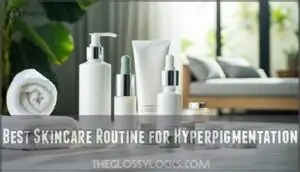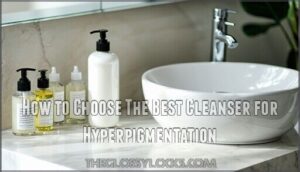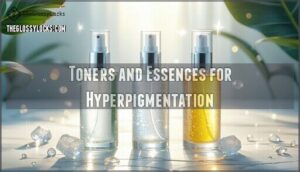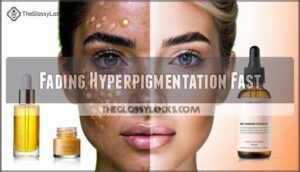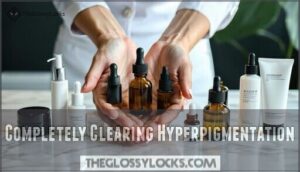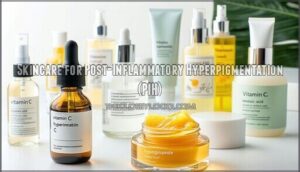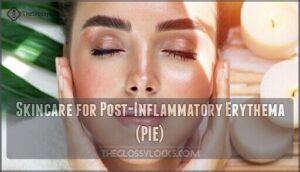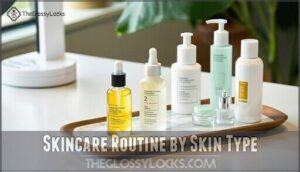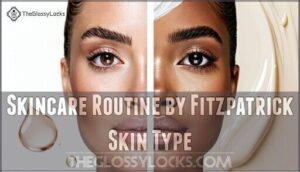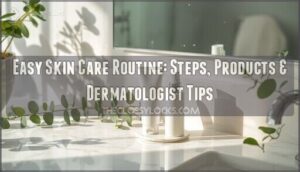This site is supported by our readers. We may earn a commission, at no cost to you, if you purchase through links.
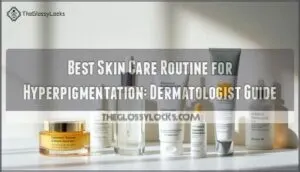
You’ll want to start with a mild cleanser, then apply vitamin C serum in the morning for brightening effects.
At night, use retinoids or chemical exfoliants like glycolic acid to accelerate cell turnover.
Niacinamide helps regulate melanin production while hydroquinone remains the gold standard for stubborn spots.
Don’t forget broad-spectrum SPF 30+ daily – it’s your most powerful prevention tool.
Consistency matters more than expensive products, and results typically appear after 6-12 weeks.
The secret lies in understanding your specific hyperpigmentation type and skin needs.
Table Of Contents
- Key Takeaways
- What is Hyperpigmentation?
- Best Skincare Routine for Hyperpigmentation
- Choosing The Right Skincare Products
- Fading Hyperpigmentation Fast
- Completely Clearing Hyperpigmentation
- Skincare Routine by Hyperpigmentation Type
- Skincare Routine by Skin Type
- Skincare Routine by Fitzpatrick Skin Type
- Preventing Hyperpigmentation
- Maintaining Results and Preventing Further Hyperpigmentation
- Frequently Asked Questions (FAQs)
- What is the best skincare routine for hyperpigmentation?
- What is the best skin care product for hyperpigmentation?
- What skincare gets rid of hyperpigmentation?
- What is the fastest way to cure hyperpigmentation?
- What skincare regimen is best for hyperpigmentation?
- What fades hyperpigmentation fast?
- What completely clears hyperpigmentation?
- Can skincare get rid of hyperpigmentation?
- How can I prevent hyperpigmentation from worsening over time naturally?
- Can hyperpigmentation be completely cured with the right treatment options?
- Conclusion
Key Takeaways
- Start with proven actives – You’ll get the best results using vitamin C serum in the morning and retinoids at night, as these ingredients directly target melanin production and accelerate cell turnover to fade dark spots.
- Never skip daily sunscreen – You’re wasting your time treating hyperpigmentation if you’re not wearing broad-spectrum SPF 30+ every day, since UV exposure triggers new dark spots and worsens existing ones.
- Match your routine to your hyperpigmentation type – You’ll see faster results when you customize your approach based on whether you’re dealing with post-inflammatory marks, melasma, or sun damage, as each requires different ingredient combinations.
- Consistency beats expensive products – You’ll achieve clearer skin by sticking with a simple routine for 8-12 weeks rather than constantly switching products, since hyperpigmentation fading requires patience and regular use of active ingredients.
What is Hyperpigmentation?
Hyperpigmentation occurs when your skin produces too much melanin in certain areas, creating dark spots or patches that appear darker than your natural skin tone.
Dark spots form when your skin overproduces melanin, leaving patches darker than your natural tone.
You’ll notice these discolored areas most commonly after acne breakouts, sun exposure, or skin injuries that trigger your body’s natural healing response, leading to hyperpigmentation.
Types of Hyperpigmentation
Four main types of hyperpigmentation affect your skin differently.
Understanding PIH vs. PIE helps target treatment effectively:
- Post-inflammatory hyperpigmentation (PIH): Dark brown spots following acne or injury
- Post-inflammatory erythema (PIE): Red or pink marks after inflammation heals
- Melasma: Symmetrical brown patches triggered by hormonal changes and sun exposure
- Sunspots: Flat brown spots from cumulative sun damage and genetic predisposition
Causes of Hyperpigmentation
Understanding what triggers hyperpigmentation helps you tackle those stubborn dark spots at their source.
UV exposure tops the list of culprits, followed by inflammation triggers and hormonal influence.
| Trigger Type | Common Causes | How It Affects Melanin |
|---|---|---|
| UV Exposure | Sun damage, tanning beds | Stimulates excess melanin production |
| Inflammation | Acne, cuts, burns | Creates post-inflammatory dark spots |
| Hormonal Changes | Pregnancy, birth control | Triggers melasma and uneven pigmentation |
| Genetic Factors | Family history, skin type | Determines susceptibility to hyperpigmentation |
Your genetics play a significant role in how your skin responds to these triggers, making some people more prone to melanin overproduction than others.
How Hyperpigmentation Affects Skin
Hyperpigmentation doesn’t just create dark spots – it changes how your skin looks and feels.
The excess melanin production leads to skin discoloration that makes your complexion appear patchy and uneven.
Beyond visual changes, hyperpigmentation can substantially impact your confidence and quality of life.
Here’s how hyperpigmentation affects your skin:
- Uneven skin tone: Dark patches create noticeable contrast against your natural complexion
- Texture changes: Areas may feel rough or develop an uneven texture over time
- Psychological effects: The visible changes often lead to self-consciousness and reduced confidence in social situations
Best Skincare Routine for Hyperpigmentation
Managing hyperpigmentation starts with using the right products and habits every day. You’ll get better results when your routine includes gentle cleansing, targeted treatment, and consistent sun protection.
Simplifying Your Skincare Routine
Tired of cluttered cabinets? A minimalist approach works wonders for your hyperpigmentation treatment.
Stick to core products, focus on streamlined steps, and let routine consistency do the heavy lifting. Prioritize gentle cleansers, a daily sunscreen, and a solid moisturizer.
Layer thoughtfully—overdoing it won’t fade dark spots faster. Small, steady steps keep your skincare routine safe and help even skin tone.
A simpler routine can also lead to enhanced skin barrier.
| Streamlined Steps | Practical Tips |
|---|---|
| Cleanser | Choose sulfate-free, gentle. |
| Moisturizer | Use daily for barrier care. |
| Sunscreen | Apply every morning, reapply. |
| Exfoliation | Limit to twice a week. |
| Consistency | Stick with what works. |
This approach emphasizes the importance of routine consistency and gentle cleansers in achieving a clear skin tone, making it a crucial part of any hyperpigmentation treatment. By following these steps and maintaining a simpler routine, individuals can effectively manage their skincare and promote healthy, even-toned skin.
Essential Ingredients for Hyperpigmentation
When targeting dark spots, five powerhouse ingredients deliver real results.
Vitamin C serum brightens while protecting against future damage.
Retinol for hyperpigmentation accelerates cell turnover to fade marks faster.
Niacinamide power reduces inflammation and evens tone.
Alpha arbutin gently lightens spots without irritation.
Asian skin is often more prone to this condition due to higher melanin levels.
These proven skin care ingredients form your hyperpigmentation treatment foundation, using Vitamin C serum, Retinol, Niacinamide, and Alpha arbutin.
Recommended Products for Hyperpigmentation
The right products can transform your hyperpigmentation journey from frustrating to successful. Vitamin C serums like Kiehl’s Clearly Corrective target dark spots effectively. Retinoid strength varies, so start gentle with retinol for hyperpigmentation.
Choose acid exfoliants like glycolic acid carefully. Niacinamide benefits include reduced inflammation and even tone. For a non-prescription alternative to hydroquinone, consider products with cysteamine hydrochloride.
- Serums: Murad Heartleaf Gentle Resurfacing Serum and Dr Idriss Major Fade Hyper Serum fade dark spots
- Creams: Cyspera Intensive Pigment Corrector offers thorough dark spot removal
- Sunscreen types: Broad-spectrum SPF 50 with iron oxide blocks visible light damage
- Toners: OLEHENRIKSEN Glow2OH 7% AHA strengthens skin barrier while exfoliating
- Acids: Kojic acid and tranexamic acid provide targeted hyperpigmentation treatment
Choosing The Right Skincare Products
Selecting the right skincare products makes the difference between seeing real results and wasting time with ineffective routines.
Understanding which ingredients target hyperpigmentation and how to match products to your skin type guarantees you’ll build a routine that actually works, using the right products to achieve real results.
Ingredients to Look for in Skincare Products
When searching for effective skincare products, focus on ingredients that target melanin production and promote cell renewal.
These powerhouse components can transform your complexion:
- Vitamin C serum: Brightens skin and inhibits excess melanin formation
- Retinoids: Accelerate cell turnover to fade dark spots effectively
- Niacinamide: Reduces inflammation while evening skin tone gently
Kojic acid and tranexamic acid also help hyperpigmentation fade faster through targeted pigment inhibition.
How to Choose The Best Cleanser for Hyperpigmentation
When picking a cleanser for hyperpigmentation, focus on gentle formulas that support your skin barrier.
Look for cleanser ingredients like ceramides or glycerin.
Skip harsh scrubs—gentle exfoliation is better for an even skin tone.
Double cleansing can help if you wear makeup.
To address dark spots, consider a hyperpigmentation-focused product.
Choose a gentle cleanser matched to your specific skin type to help fade dark spots without irritation.
Toners and Essences for Hyperpigmentation
Once your cleanser sets the stage, toners and essences step in to boost your routine.
Exfoliating toners with AHAs or BHAs help clear away dullness and prep for better absorption. Essences deliver hydration and target hyperpigmentation for smoother, even skin tone.
Try these:
- Exfoliating toner (AHA/BHA)
- Brightening essence with vitamin C
- Hydrating essence for ideal skin pH
Fading Hyperpigmentation Fast
When you want faster results from your hyperpigmentation treatment, targeted approaches work better than waiting for gentle products alone.
Strike while your skin is ready—targeted treatments deliver the breakthrough your dark spots have been waiting for.
The key is using potent ingredients like spot treatments, chemical exfoliants, and retinoids that directly target dark spots and speed up skin cell renewal.
Spot Treatments for Hyperpigmentation
Targeted spot treatments deliver concentrated ingredients directly to dark marks for faster results.
These potent formulas penetrate deeper than regular serums to accelerate fading.
| Ingredient | Strength | Best For |
|---|---|---|
| Hydroquinone | 2% prescription | Stubborn melasma spots |
| Kojic Acid | 1-4% concentration | Sun damage marks |
| Tranexamic Acid | 2-5% formula | Post-acne hyperpigmentation |
Apply spot treatments only to affected areas using a cotton swab.
Start with every other night to avoid irritation.
Cysteamine cream and alpha arbutin offer gentler alternatives for sensitive skin.
Consistent use of exfoliants helps to maintain results, but daily sun protection is also essential.
Chemical Exfoliants for Hyperpigmentation
Chemical exfoliants work like gentle erasers for stubborn dark spots. They’re your secret weapon when spot treatments aren’t cutting it.
- AHA vs BHA Selection: Glycolic and lactic acids (AHAs) target surface pigmentation while salicylic acid (BHA) penetrates deeper into pores. Choose AHAs for general hyperpigmentation and BHAs for acne-related dark spots.
- Product Strength Guidelines: Start with 5-10% concentrations for AHAs and 1-2% for BHAs. Higher percentages aren’t always better—consistency beats intensity.
- Exfoliation Frequency Rules: Begin twice weekly then gradually increase. Your skin will tell you when it’s ready for more frequent use.
- Sensitive Skin Approach: Use lower concentrations and avoid layering exfoliants with other actives like kojic acid or alpha arbutin initially. Many users seek effective exfoliation products to address this concern.
How to Use Retinoids for Hyperpigmentation
Now you’re ready to tackle those stubborn dark spots with retinoids.
Start with a lower concentration like 0.25% retinol and apply at night only. Mix with moisturizer to manage irritation during the first weeks.
Gradually increase application frequency from twice weekly to nightly as your skin adapts.
Tretinoin offers faster skin pigmentation reduction than over-the-counter options, but requires patience for long-term use results.
Completely Clearing Hyperpigmentation
You can completely clear hyperpigmentation with a targeted routine that combines professional treatments, at-home devices, and the right skincare products.
Consistency and patience are key, as results take time and depend on your skin type and the cause of the dark spots, requiring a consistent approach to achieve the desired outcome with professional treatments.
Professional Treatments for Hyperpigmentation
Breaking through stubborn dark spots often requires professional intervention from your dermatologist.
These advanced treatments work faster than topical products alone.
Your dermatologist can recommend several powerful options:
- Chemical Peels – Glycolic and TCA peels remove damaged skin layers and accelerate cell turnover
- Laser Resurfacing – Targets melanin clusters with precision light therapy for dramatic results
- Microneedling – Creates controlled micro-injuries that stimulate collagen and fade pigmentation
- Microdermabrasion – Gently buffs away surface discoloration through professional exfoliation
These dermatological treatments offer faster, more dramatic results than at-home care.
At-Home Devices for Hyperpigmentation
If in-office laser treatment isn’t for you, at-home devices can help fade stubborn hyperpigmentation with steady use.
Here are three popular options:
- LED Therapy: Green and red lights target dark spots and boost skin renewal.
- Microcurrent Devices: Stimulate cell repair, helping even skin tone.
- Microneedling Pens: Encourage collagen and fade discoloration for smoother, brighter skin.
Combining Skincare Products for Hyperpigmentation
Combining skincare products reveals your hyperpigmentation routine’s full potential.
Start with layering actives strategically—vitamin C serum in the morning followed by niacinamide.
At night, alternate retinoids with glycolic acid to avoid ingredient conflicts.
Product order matters: thinnest to thickest consistency maximizes efficacy.
This routine synergy approach accelerates pigmentation correction and helps brighten skin faster than single products alone.
Skincare Routine by Hyperpigmentation Type
You’ll get the best results when you match your skincare routine to the specific type of hyperpigmentation you have.
Each kind—like post-inflammatory marks, redness, or melasma—needs a customized approach for effective fading and prevention.
Skincare for Post-Inflammatory Hyperpigmentation (PIH)
Regarding postinflammatory hyperpigmentation (PIH), patience pays off.
PIH causes those stubborn dark marks after acne or injury.
Start with gentle cleansers, then layer in PIH ingredients like vitamin C, niacinamide, and azelaic acid for skin brightening.
Daily sunscreen is non-negotiable for PIH prevention.
Stick with your routine, and you’ll see PIH severity fade over time.
Skincare for Post-Inflammatory Erythema (PIE)
PIE differs from postinflammation hyperpigmentation because it involves damaged blood vessels rather than excess melanin. Understanding PIE causes helps target treatment effectively.
Unlike dark spots, these red marks need gentle care and barrier repair. Daily sunscreen remains essential for your skincare routine.
- Apply soothing serums with green tea or niacinamide for redness reduction
- Use gentle cleansers and lukewarm water to avoid further irritation
- Consider vascular lasers for stubborn PIE when topical treatments aren’t enough
Skincare for Melasma
Melasma brings unique challenges with its hormonal triggers and stubborn patches.
This condition often appears during pregnancy (pregnancy melasma) and has strong genetic components. Your treatment approach needs targeted ingredients like tranexamic acid and hydroquinone alongside rigorous sun protection.
Your Melasma-Fighting Skincare Routine
Morning Night
Skincare Routine by Skin Type
Your skin type determines which products work best for treating hyperpigmentation without causing irritation or breakouts.
Different skin types need customized approaches to safely fade dark spots while maintaining healthy skin barrier function, and understanding this is key to treating hyperpigmentation.
Skincare for Dry Skin With Hyperpigmentation
If you have dry skin with hyperpigmentation, start by using hydrating cleansers that won’t strip your skin’s natural oils.
Choose gentle exfoliation methods like AHAs twice weekly to remove dead skin cells without irritation.
Focus on lipid replenishment with ceramide-rich moisturizers to restore your moisture barrier.
Layer hydrating serums before sunscreen to boost skin hydration while protecting against further hyperpigmentation.
Using a humidifier can help with combating dry air to achieve healthy skin.
Skincare for Oily Skin With Hyperpigmentation
Oily skin doesn’t mean you can’t tackle hyperpigmentation effectively.
Your skincare routine should focus on oil control and sebum regulation while targeting dark spots.
Choose non-comedogenic products with niacinamide for pore minimizing and acne prevention.
Incorporate matte sunscreen daily to protect healing skin.
Chemical exfoliants like salicylic acid work double duty – controlling excess oil while promoting cell turnover to fade hyperpigmentation marks faster.
Skincare for Sensitive Skin With Hyperpigmentation
When sensitive skin meets hyperpigmentation, patience becomes your best friend.
Your skin barrier needs extra protection while fighting dark spots.
- Gentle Exfoliation: Use mild AHAs once weekly to avoid irritation
- Barrier Repair: Apply ceramide-rich moisturizers to strengthen compromised skin
- Soothing Ingredients: Choose niacinamide over harsh acids for calmer results
- Product Patch-Testing: Test new treatments on small areas first to prevent reactions
Always use mineral sunscreen to prevent sunscreen sensitivity while protecting against further hyperpigmentation.
Skincare Routine by Fitzpatrick Skin Type
Your skin type affects how hyperpigmentation forms and responds to treatment.
Lighter skin types need gentler approaches while darker skin types require more careful ingredient selection to avoid irritation and worsening pigmentation.
Skincare for Fitzpatrick Skin Type I-III
Fair-skinned folks face unique challenges when treating hyperpigmentation. Your skin’s sun sensitivity means you burn easily but respond well to targeted treatments when used properly.
Start with gentle exfoliation using AHAs like lactic acid twice weekly. Your skin tolerates most active ingredients but needs careful introduction.
Layer a vitamin C serum under broad-spectrum SPF 30+ sunscreen daily for barrier strengthening and sun damage repair. To support skin health, consider a diet rich in antioxidants.
- Gentle exfoliation: Use lactic or glycolic acid 2x weekly for product absorption
- Redness reduction: Apply niacinamide serum to calm irritation and support even skin tone
- Sun protection: Wear SPF 30+ daily to prevent further hyperpigmentation
- Gradual retinoid introduction: Start with low-strength formulas for your skincare routine
- Patch testing: Test new products on small areas before full application
Skincare for Fitzpatrick Skin Type IV-VI
If you have Fitzpatrick skin type IV-VI, your melanated skin faces higher PIH risk and keloid formation potential.
Focus on gentle ingredients like vitamin C and niacinamide to control melanin production without triggering inflammation.
Use sunscreen for hyperpigmentation daily since your sun sensitivity varies but product absorption requires careful selection to achieve even skin tone.
Preventing Hyperpigmentation
Prevention is your strongest weapon against hyperpigmentation since it’s much easier to stop dark spots from forming than to fade them afterward.
You’ll save time and money by protecting your skin barrier and avoiding UV damage rather than treating hyperpigmentation once it appears, and this approach is part of a broader strategy of prevention.
Daily Sun Protection for Hyperpigmentation
Daily sun protection forms your strongest defense against hyperpigmentation.
You need broad-spectrum SPF 30 or higher applied every morning, regardless of weather.
Here’s your protection playbook:
- Mineral sunscreens with zinc oxide offer gentler coverage for sensitive skin
- Tinted sunscreens provide extra coverage while blocking harmful UV rays
- Sun protective clothing and avoiding peak sun hours (10am-4pm) boost your defense
SPF reapplication every two hours keeps your UV protection working effectively.
How to Prevent Inflammation and Trauma
Prevention starts with breaking the picking habit. Your fingers carry bacteria that can worsen inflammation and create new dark spots.
Use gentle cleansing techniques with lukewarm water and soft motions. Treat acne promptly with targeted products to prevent scarring.
Soothe irritation with cooling ingredients like aloe or niacinamide. Maintain a healthy barrier through consistent moisturizing and avoiding harsh scrubs, which helps in prevention.
Maintaining Healthy Skin to Prevent Hyperpigmentation
Beyond preventing inflammation and trauma, maintaining overall healthy skin forms your best defense against hyperpigmentation.
Think of your skin barrier as your body’s security system – when it’s strong, unwanted pigmentation can’t break through.
Your daily habits matter more than expensive treatments. Gentle cleansing removes impurities without disrupting your skin’s natural protection. Hydration importance can’t be overstated – well-moisturized skin repairs faster and resists damage better.
- Eat antioxidant-rich foods like berries and leafy greens to fight free radical damage
- Sleep 7-9 hours nightly so your skin can complete its natural repair cycle
- Stay hydrated with 8 glasses of water daily for ideal cell function
- Never skip sunscreen – even SPF 30 prevents 97% of sun damage
A healthy lifestyle supports skin protection from within while consistent SPF use guards against external threats.
Maintaining Results and Preventing Further Hyperpigmentation
You’ve successfully faded your dark spots, but maintaining clear skin requires ongoing effort and smart habits.
Consistency with your proven routine and vigilant sun protection will keep hyperpigmentation from returning while preserving your hard-earned results.
Maintenance Treatments for Hyperpigmentation
Once you’ve achieved clearer skin through pigmentation correction, maintenance treatments become your safety net.
Professional options like chemical peels and laser therapy offer powerful skin texture improvement every few months.
At-home routine adjustments with preventative actives like vitamin C serums maintain progress.
Gentle exfoliation twice weekly supports skin tone correction while consistent SPF protects your investment.
Remember, hydration importance can’t be overstated—well-moisturized skin heals better and maintains results longer.
How to Keep Your Skincare Routine Consistent
Build a consistent routine by stacking your skincare habits with daily tasks—think brushing your teeth, then applying sunscreen.
Set realistic goals, like a two-step morning routine.
Store products within reach, making it easy to stick with your plan.
Track progress to see changes in your skin tone, and simplify your routine, find enjoyment in small wins, and use these skincare tips to fight hyperpigmentation.
Monitoring Progress and Adjusting Your Skincare Routine
Maintaining consistency with your routine is just the start—knowing when and how to make adjustments separates successful hyperpigmentation treatment from frustrating plateaus.
Your skin’s needs change with seasons, hormones, and progress levels, making consistent evaluation your best tool for long-term success.
Track progress through monthly photos taken in consistent lighting.
Document which ingredients work best and note any irritation patterns.
This data helps you make informed routine tweaks rather than random changes.
- Track Progress: Take monthly photos and maintain a skincare journal to monitor improvements and setbacks
- Product Cycling: Rotate active ingredients seasonally to prevent tolerance and maintain effectiveness
- Seasonal Adjustments: Modify your routine based on weather changes and varying sun exposure levels
- Consistent Evaluation: Assess your hyperpigmentation monthly and adjust product concentrations accordingly
The right products require patience—most ingredients show results after 8-12 weeks of consistent use.
Resist the urge to abandon effective products too quickly.
Frequently Asked Questions (FAQs)
What is the best skincare routine for hyperpigmentation?
If Cleopatra had sunscreen, she’d have loved this: cleanse gently, use vitamin C serum, apply a retinoid at night, moisturize, and never skip broad-spectrum SPF 30+.
Add niacinamide and exfoliate twice weekly for best results.
What is the best skin care product for hyperpigmentation?
For hyperpigmentation, you’ll get the best results with vitamin C serums during the day and retinoids at night. Daily broad-spectrum SPF 30+ sunscreen is absolutely essential to prevent further darkening.
What skincare gets rid of hyperpigmentation?
Vitamin C serums brighten skin while retinoids accelerate cell turnover to fade dark spots.
AHA exfoliants remove surface pigmentation.
You’ll need consistent sunscreen daily since UV exposure worsens hyperpigmentation and undoes your progress.
What is the fastest way to cure hyperpigmentation?
Breaking through stubborn dark spots feels like chasing shadows, but consistent use of vitamin C, retinoids, and daily SPF 30+ sunscreen delivers the fastest results within 8-12 weeks.
What skincare regimen is best for hyperpigmentation?
Use gentle cleanser daily, vitamin C serum mornings, retinoid nights, moisturizer twice daily, and broad-spectrum SPF 30+ sunscreen. Consistency prevents new spots while active ingredients fade existing pigmentation.
What fades hyperpigmentation fast?
If you want those dark spots to vanish faster than socks in a dryer, reach for retinoids, vitamin C, and niacinamide.
Pair them with daily sunscreen, and you’ll see real results—just don’t expect overnight magic.
What completely clears hyperpigmentation?
Nothing completely clears hyperpigmentation permanently. However, consistent use of retinoids, vitamin C, and daily SPF can dramatically fade spots over 3-6 months, achieving near-complete clearance for many people.
Can skincare get rid of hyperpigmentation?
Studies show skincare can reduce hyperpigmentation by up to 75% with consistent use.
You’ll see improvements with vitamin C, retinoids, and acids, but it takes patience and daily sunscreen for lasting results.
How can I prevent hyperpigmentation from worsening over time naturally?
Daily sunscreen prevents UV damage that triggers dark spots. Avoid picking skin to prevent post-inflammatory hyperpigmentation. Wear protective clothing and seek shade during peak hours.
Can hyperpigmentation be completely cured with the right treatment options?
Hyperpigmentation can markedly improve with consistent treatment, but complete elimination isn’t always possible.
Your skin type, pigmentation depth, and treatment adherence determine results.
Most people see substantial fading rather than total clearance.
Conclusion
Surprisingly, you’ve discovered what countless others have learned the hard way – the best skin care routine for hyperpigmentation isn’t about having the most expensive products on your vanity.
Success comes from understanding your specific pigmentation type and choosing proven ingredients like vitamin C, retinoids, and niacinamide.
Consistency beats complexity every time, so start with one active ingredient, add sun protection daily, and give your routine 8-12 weeks to show results.
Your patient approach will reward you with clearer, more even-toned skin, demonstrating that consistency is key to achieving the desired outcome.
- https://111skin.com/en-us/blogs/111journal/skincare-routines-for-hyperpigmentation-prone-skin
- https://www.neora.com/blog/neora-product/morning-skincare-routine-to-combat-hyperpigmentation/
- https://miiskin.com/anti-aging-beauty/best-ingredients-for-hyperpigmentation/
- https://www.aad.org/public/everyday-care/skin-care-secrets/routine/fade-dark-spots
- https://jaxbeachderm.com/2024/11/10/how-to-prevent-and-treat-hyperpigmentation/

